Should You Deadhead Perennial Daisies for a Bloomin’ Garden?
When you deadhead your perennial daisies, you’ll enjoy healthier plants and more vibrant flowers throughout the growing season. Regular deadheading helps redirect the plant’s energy into producing new blooms instead of forming seeds.
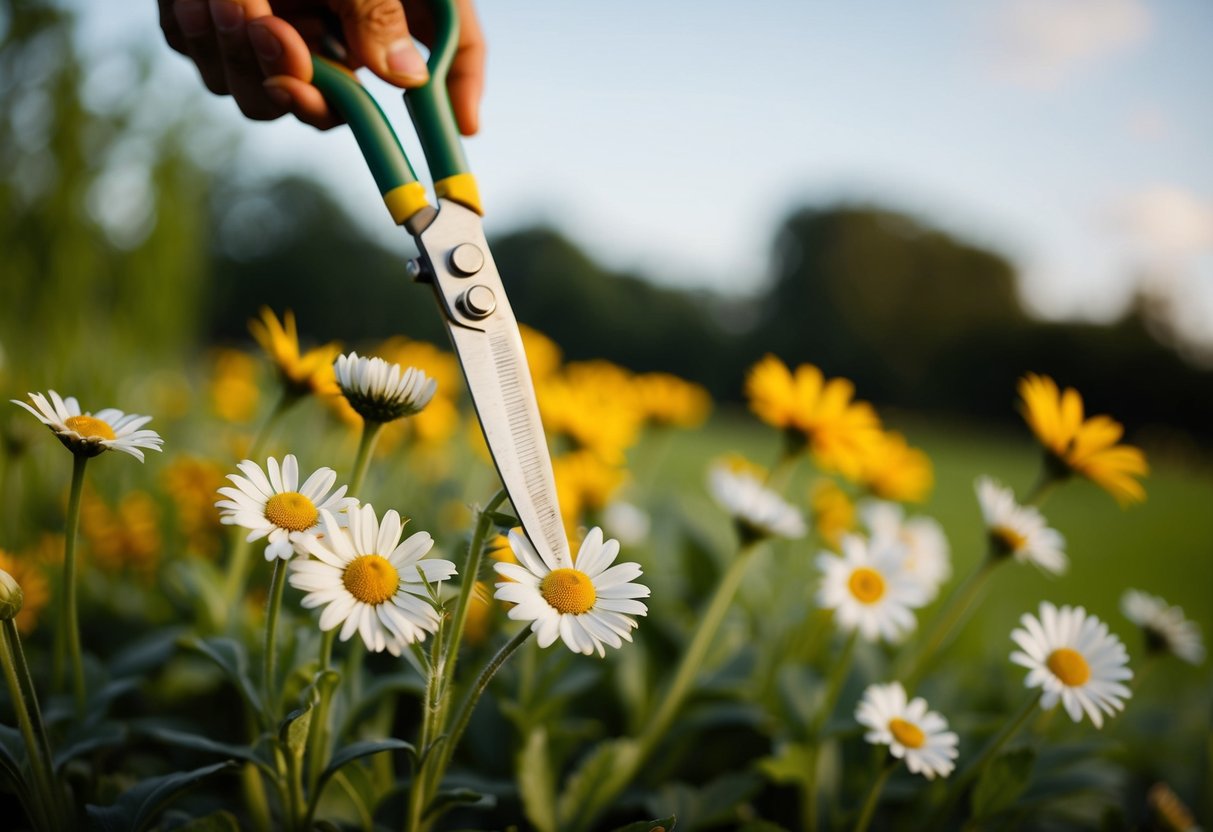
Perennial daisies are a popular choice among gardeners due to their bright and cheerful appearance. By removing the spent flowers, you are not only maintaining the beauty of your garden but also encouraging more abundant blooming. Using tools like pruning shears can make this process even easier and more efficient.
Beyond enhancing the aesthetic appeal, deadheading daisies can make them more resilient and bushier. This simple practice helps prevent the plants from becoming leggy. So, gather your gardening gloves and get ready to keep your daisies looking their best!
Basics of Deadheading
Deadheading is an important gardening practice that keeps your daisies looking vibrant and extends their bloom time. It involves removing faded flowers to promote new growth and prevent seed production. To deadhead daisies effectively, you’ll need specific tools and the right timing.
Understanding Deadheading and Its Purpose
Deadheading involves cutting off faded or spent flowers. This helps your daisies redirect energy from seed production to forming new blooms. It keeps your garden looking fresh and encourages more florals throughout the season. Deadheading also supports the overall health of your plants, as it can minimize disease by removing dead parts. With regular attention, you can enjoy a garden full of lively and colorful daisies.
When to Deadhead Daisies
Timing is key to effective deadheading. Start when flowers begin to fade, wilt, or change color. Using pruning shears, cut the stem down to the first bud or just above a healthy leaf.
Early in the summer, regular deadheading helps prolong your daisies’ flowering season. When fall arrives, focus on tidying up by removing faded blooms to prepare for the dormant winter months.
Tools for Deadheading
Having the right tools makes deadheading easier and more effective. Pruning shears or sharp scissors work well for cutting stems cleanly. Make sure they’re clean to prevent spreading disease. Gardening gloves protect your hands, especially if the plants are a bit rough or sticky. Consider having a bucket or bag nearby for collecting the dead flowers and stems you remove. This helps keep your garden tidy and can enhance your gardening routine’s overall experience.
Types of Daisies
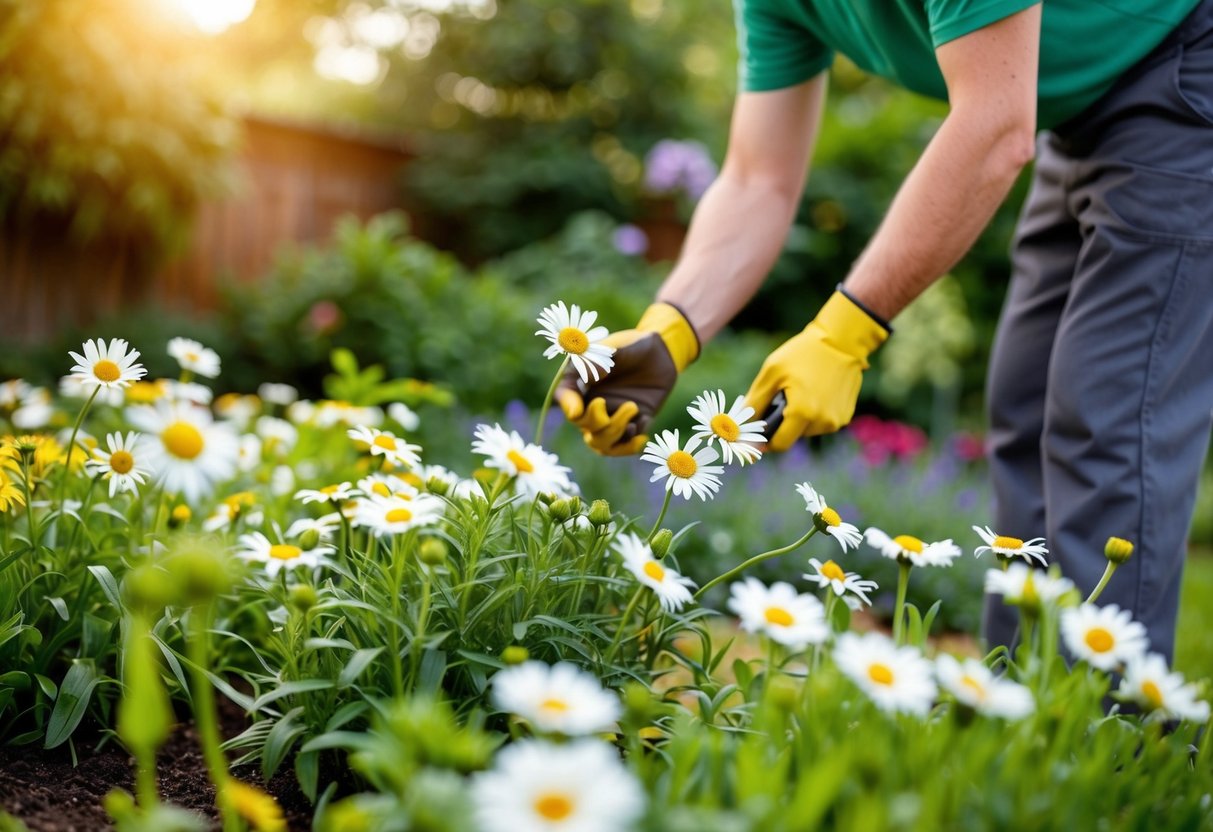
Different types of daisies offer a variety of characteristics and care needs. Some daisies like the Shasta are known for their vibrant blooms, while others like the Gerbera have specific deadheading requirements. The Oxeye daisy stands out for its unique look and growth habits.
Characteristics of Shasta Daisies
Shasta daisies are popular garden perennials. These daisies are known for their bright white petals and yellow centers, resembling classic daisy imagery. Shasta daisies belong to the Asteraceae family and tend to bloom from early summer to the first frost.
They can grow up to three feet tall and prefer well-drained soil. When it comes to maintenance, regular deadheading is key to promoting continuous blooms. You should use pruning shears to remove faded flowers, cutting the stem back to a new growth point. This encourages bushier growth and prevents legginess. Shasta daisies thrive in full sun and can adapt to a range of soil types, making them a versatile addition to any garden.
Gerbera Daisy and Deadheading Needs
The Gerbera daisy, a member of the Asteraceae family, is well-loved for its bright, bold flowers in various colors. Unlike some other daisies, Gerbera daisies have larger petals and a more striking appearance. They are often used in floral arrangements due to their beauty.
When it comes to care, these daisies have specific deadheading needs. Regularly removing spent blooms helps improve both the plant’s appearance and health. To deadhead, cut the stem down to the base instead of just the flower. This prevents pest infestations and maintains the plant’s vigor. Gerbera daisies prefer a spot with plenty of sunlight and well-draining soil to flourish.
The Unique Oxeye Daisy
The Oxeye daisy is a charming perennial that also belongs to the Asteraceae family. These daisies are characterized by their smaller, white flowers with yellow centers. They often grow up to two feet tall and love full sunlight. Their simple beauty makes them easy to incorporate into any garden setting.
Oxeye daisies are relatively low maintenance and adaptable. They can withstand a range of environmental conditions but flourish best in well-draining soil. Although they don’t require frequent deadheading, removing old flowers can help you manage the plant’s growth and encourage more blooms. This type of daisy is perfect for gardeners looking for a carefree and attractive addition to their garden.
The How-To of Deadheading Daisies
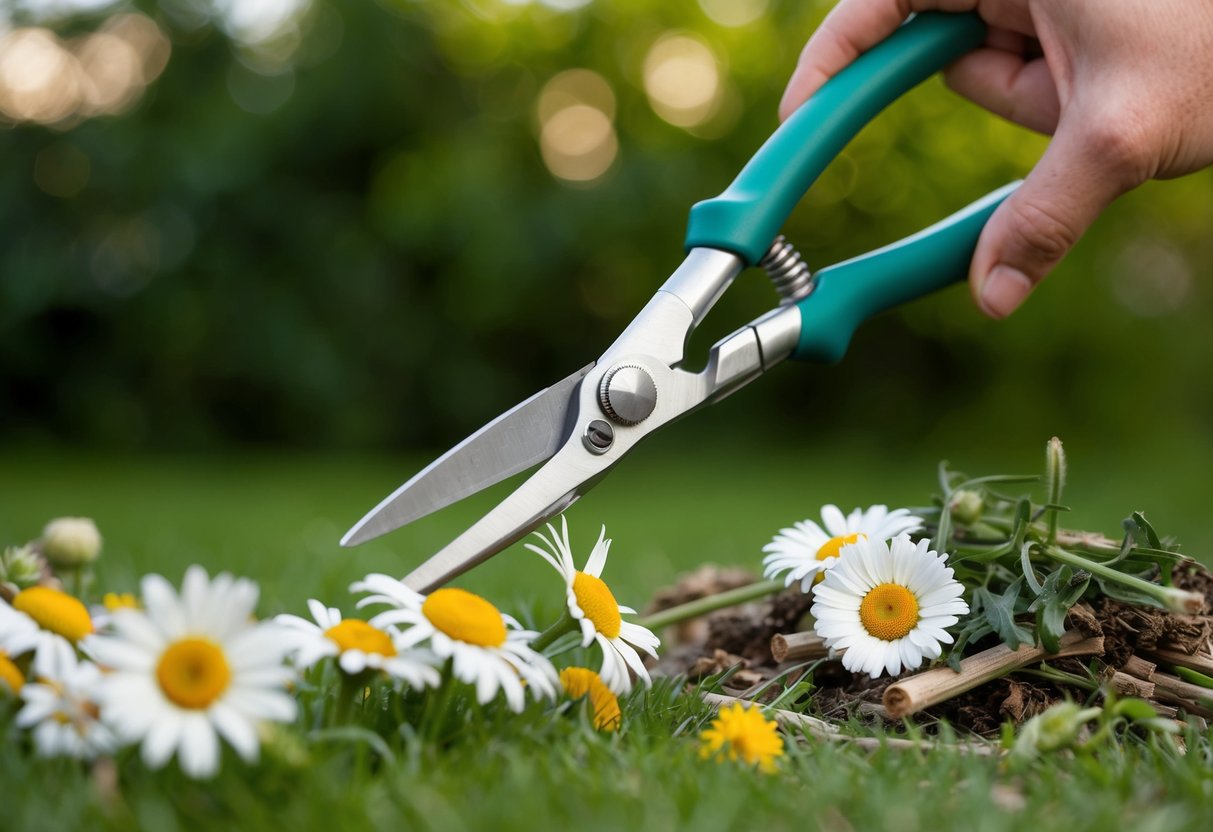
Deadheading daisies is crucial for maintaining healthy and vibrant blossoms. Removing spent blooms helps channel the plant’s energy into producing new flower heads. It ensures longer flowering periods and keeps your garden looking fresh.
Step-by-Step Guide to Deadhead Daisies
-
Gather Your Tools: Use sharp scissors or pruning shears to make clean cuts. This prevents damage to the plant.
-
Spot the Bloom to Cut: Find the flower head that looks faded, withered, or brown, as these are spent flowers.
-
Make the Cut: Snip the stem just above a healthy leaf or lateral bud to promote new growth. This encourages more blooms.
-
Dispose of the Debris: Collect the removed spent blooms and add them to your compost pile. This helps keep your garden tidy.
Identifying Spent Flowers
Knowing when a daisy flower is spent is essential to effective deadheading. Spent flowers often display faded colors, shriveled petals, and a drooping stem. They may also have brown or dry edges.
When identifying these flowers, look closely at the overall health of the petals. If the daisies look less vibrant or sturdy than fresh ones, it’s time to deadhead them.
By keeping an eye on your daisies and promptly removing faded flowers, you help the plant focus on producing vibrant new blooms, keeping your garden lively and colorful.
Optimizing Daisy Health and Blooms
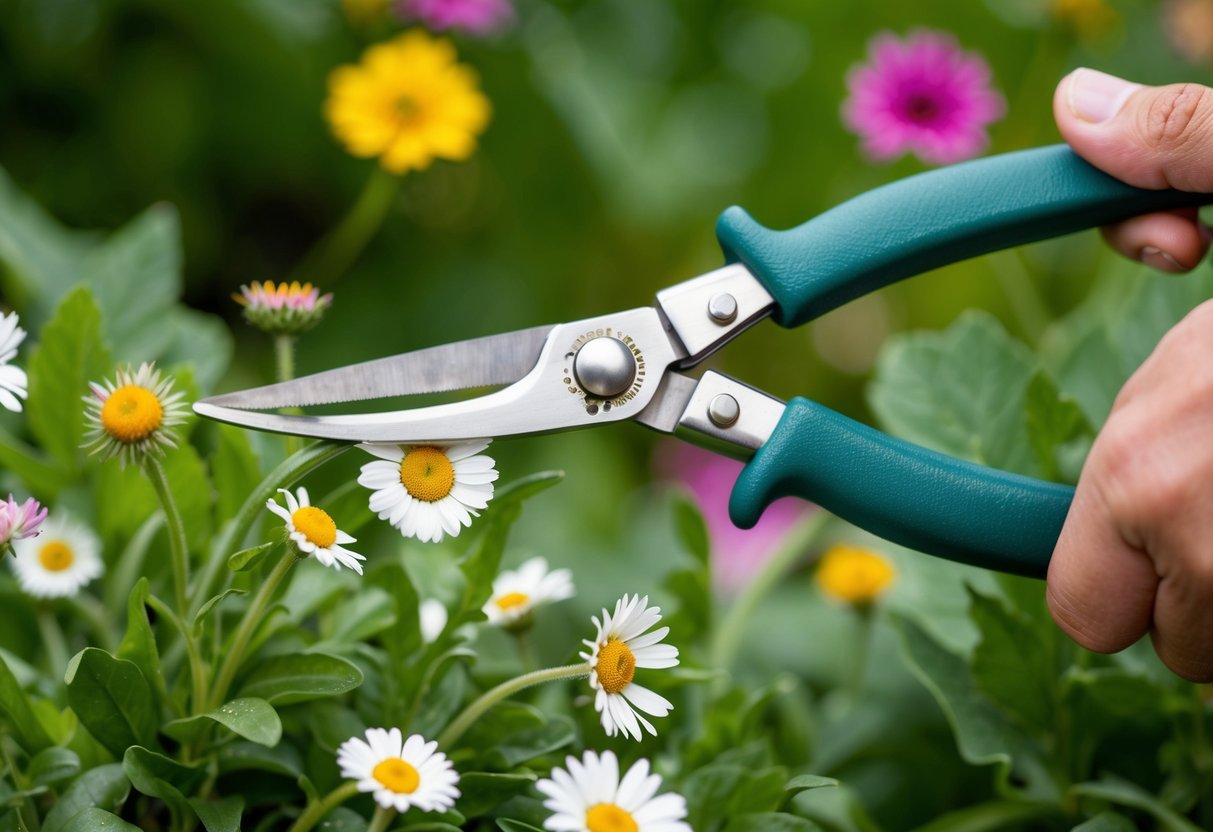
To keep your daisies blooming beautifully, regular care is key. This includes deadheading, which encourages more blooms, and proper fertilization to nourish the plant. These practices contribute to healthier daisies and a longer blooming season.
Benefits of Regular Deadheading
Deadheading daisies involves removing spent blooms. This practice helps your plant focus its energy on producing more blossoms rather than forming seeds. By cutting off old flowers, you allow your daisy to conserve resources, which promotes healthier growth.
Regular deadheading also stimulates the plant to produce new buds. This results in more blooms over the blooming period. The process is simple: just snip off the old flowers down to the next leaf or bud. This keeps your daisy looking vibrant throughout the season.
Promoting Longer Blooming Seasons
When you consistently deadhead, your daisy is encouraged to bloom for a longer time. By preventing seed development, the plant redirects energy to new growth. This not only extends the blooming season but also keeps your garden bright and colorful.
To maximize the blooming period, pay attention to signs of wilting or browning in flowers. Remove them promptly. Doing this helps in maintaining the plant health and ensures that your daisies remain a focal point in your garden. Consistent care leads to a longer blooming season, brightening your garden with healthy blooms.
Fertilization and Care Post-Deadheading
After you’ve deadheaded your daisies, fertilizing them can boost their health and encourage more buds. Use a balanced fertilizer suitable for flowering plants. Apply it according to the package instructions to avoid over-fertilizing, which can harm the plant.
Water your daisies regularly, especially during dry periods, allowing the soil to remain moist but not waterlogged. This encourages root growth and supports plant health. Proper fertilization and care after deadheading help maintain the plant’s vigor and ensures continuous blooming. Focus on maintaining a good balance of nutrients to keep your daisies thriving.
Gardening Tips for a Tidier Garden
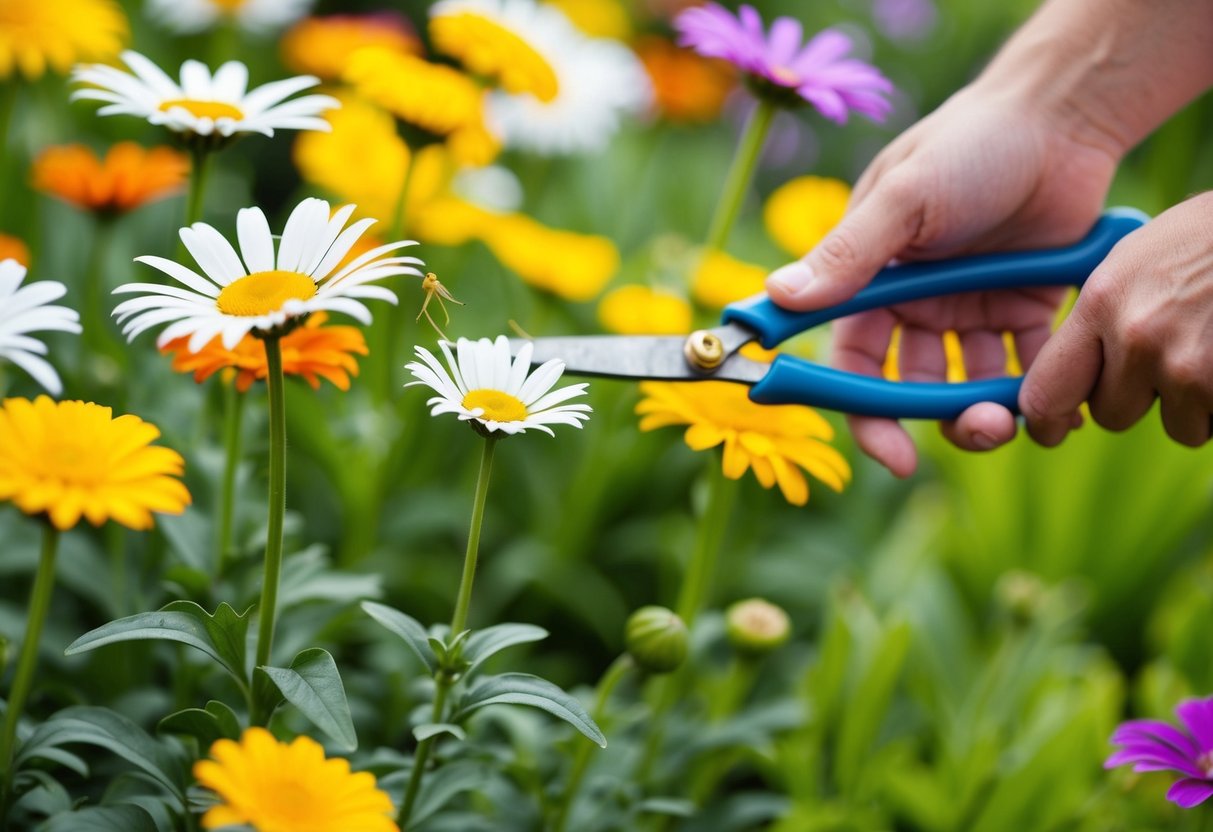
Keeping your garden tidy involves techniques that not only improve appearance but also promote healthy growth. You can prevent unwanted spread and make good use of waste by following these simple tips.
Preventing Self-Seeding
When your plants drop seeds, they can end up sprouting all over your garden. This might lead to a more cluttered look. By removing spent flowers, you stop plants from going to seed. This focus on tidiness helps to keep your garden space organized and manageable.
Deadheading perennials like daisies is key to preventing self-seeding. This step ensures that plants put energy into blooming again rather than seed production. Regular maintenance also means less work weeding out unwanted seedlings later.
Using Deadheaded Blooms for Compost
Don’t toss deadheaded blooms in the trash. They are perfect for making compost, enriching the soil, and supporting new plant growth. Adding them to your compost pile ensures they break down into valuable nutrients.
To create compost, place blooms alongside grass clippings and kitchen scraps. Turning the pile often speeds up the composting process, providing your garden with a nutrient-rich boost.
Using deadheaded blooms for compost helps recycle garden waste while keeping your garden tidy.







